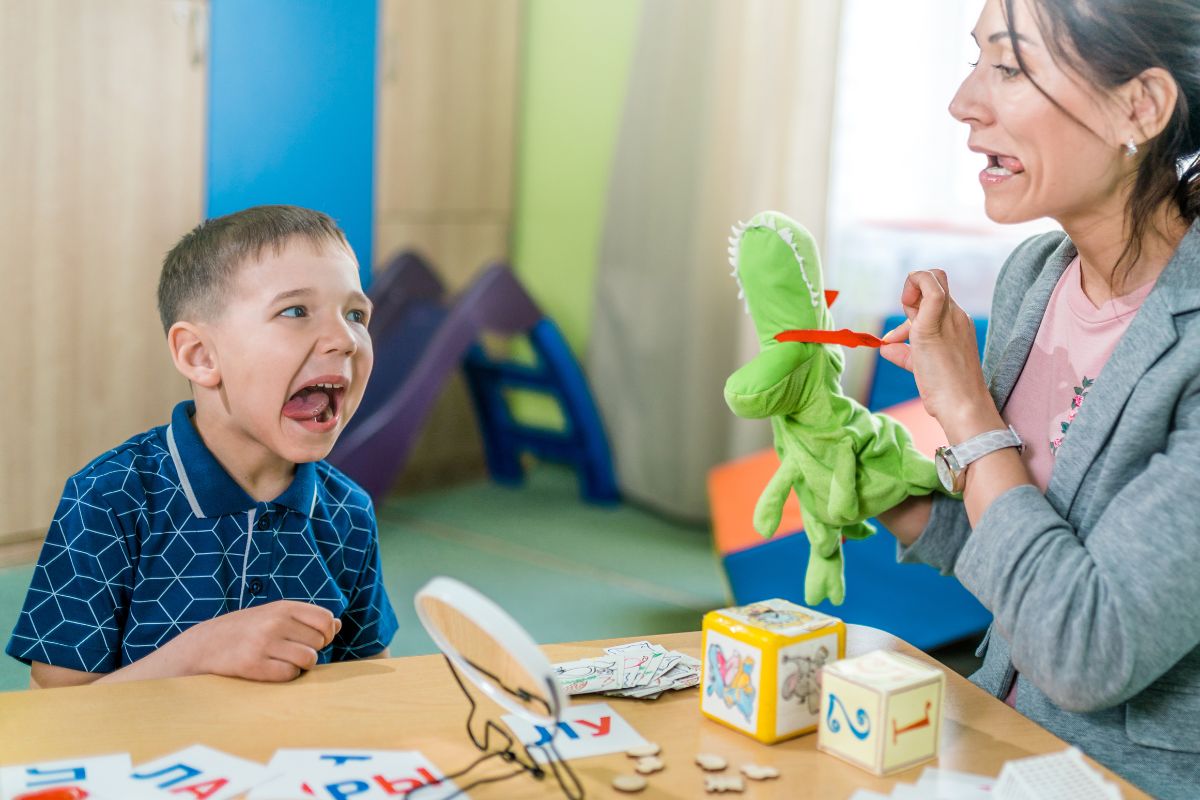Tongue twisters are playful phrases designed to challenge pronunciation and enhance linguistic agility. They serve as excellent tools for improving your English, particularly in the areas of diction and fluency.
Engaging with tongue twisters can help non-native speakers and even advanced learners refine their pronunciation, articulate sounds more clearly, and develop a stronger command of the English language.
![a infographic about Th Tongue Twisters To Improve Your English + Pronunciation [2025]](https://phoenixenglishlang.com/wp-content/uploads/2024/03/unnamed-5-2.png)
Important Points:
- Purpose of Tongue Twisters: The primary goal of tongue twisters is to improve pronunciation and speech clarity.
They require focused articulation, which helps learners become more aware of how sounds are produced and strung together in rapid succession.
- Cognitive and Physical Benefits: Practicing tongue twisters not only enhances verbal skills but also strengthens the muscles used in speech, leading to overall better pronunciation.
Additionally, they help improve cognitive functions related to language processing, making individuals more adept at manipulating language quickly.
- Variety in Difficulty: Tongue twisters come in various levels of difficulty.
Beginners may start with simpler phrases, while more advanced learners can challenge themselves with intricate and complex constructions. For example:
– Beginner: “She sells seashells by the seashore.”
– Advanced: “How can a clam cram in a clean cream can?”
- Fun and Engaging: Incorporating tongue twisters into language practice creates a fun and light-hearted atmosphere.
This engagement can lead to greater motivation and persistence, allowing learners to enjoy the process of mastering challenging sounds in English.
- Contextual Use: Tongue twisters can also be beneficial for specific accents or dialects, as they often highlight particular sounds that may be challenging.
Knowing how to pronounce certain phonemes correctly is essential for clear communication and is particularly useful when learning English as a second language.
You might also enjoy:Which of the Following: Definition + Complete Usage + Grammar
As we delve into the topic of “The Tongue Twisters To Improve Your English + Pronunciation [2025],” we will present a collection of effective tongue twisters along with tips and techniques to practice them successfully.
This guide will focus on modern methods that promote active learning and interaction.
—
In the pursuit of mastering English, pronunciation often stands out as a crucial skill that can greatly influence communication effectiveness.
Tongue twisters—those whimsical phrases that twist the tongue—are not just a source of amusement; they are powerful tools for refining pronunciation and improving overall language proficiency.
Through engaging with tongue twisters, learners can explore the intricate sounds of English in a way that is both challenging and enjoyable.
The 2025 Method emphasizes interactive strategies that foster deeper engagement and retention, making the process of learning pronunciation skills more effective.
At their core, tongue twisters facilitate the development of phonemic awareness, vital for any language learner.
They prompt the speaker to concentrate on specific sounds and their combinations, aiding in the formation of clearer, more articulate speech.
Classic examples like “Peter Piper picked a peck of pickled peppers” require precise diction and temporal coordination, providing an excellent workout for the vocal apparatus.
As we compile various tongue twisters categorized by complexity and phonetic focus, this guide will include actionable tips on how to practice them effectively.
Techniques such as slowing down when first attempting a phrase, gradually increasing speed, and focusing on enunciation will be explored to maximize learners’ pronunciation improvement.
Ultimately, the value of tongue twisters lies in their ability to transform the routine process of learning into a dynamic and enjoyable experience.
By delving into this collection, learners will not only enhance their pronunciation skills but also strengthen their confidence in speaking English, leading to clearer communication and deeper connections with others.
Join us as we embark on this entertaining journey to improve your English through the playful challenge of tongue twisters.
You Might Also Enjoy:Reinforce Vs Reenforce: 10 Differences + Examples [2025]
What is the hardest tongue twister in the world 2023?

Tongue twisters are phrases designed to challenge our pronunciation skills, often leading to humorous mispronunciations. In 2023, one of the most challenging tongue twisters is “Pad kid poured curd pulled cod,” a phrase developed by researchers at the Massachusetts Institute of Technology (MIT).
The Origin of “Pad Kid Poured Curd Pulled Cod”
This tongue twister was created by MIT psychologists who were studying the intricacies of speech production. Their aim was to craft a phrase that would be exceptionally difficult to articulate. The result, “Pad kid poured curd pulled cod,” proved to be so challenging that many participants in their study struggled to say it even once without stumbling.
Why Is It So Difficult?
The complexity of this tongue twister lies in its combination of similar sounds and rapid alternation between different consonant clusters. Here are a few reasons why it is particularly challenging:
1.Consonant Clusters: The phrase includes multiple consonant clusters (e.g., “pd,” “kd,” “rd,” “ld”) that are tough to pronounce in quick succession.
2.Phonetic Similarity: The sounds in the phrase are phonetically similar, which increases the likelihood of errors. For example, “pad” and “poured” share the initial “p” sound, while “curd” and “cod” share the “d” sound.
3.Rapid Alternation: The tongue has to move quickly between different positions in the mouth, leading to slips and mispronunciations.
You might also enjoy:Where Does “How is your Day Going?” Originate From?
Other Notable Tongue Twisters
While “Pad kid poured curd pulled cod” is considered the hardest, there are several other tongue twisters that are notoriously difficult.
For instance, “The sixth sick sheik’s sixth sheep’s sick” is another challenging phrase that has been recognized by the Guinness Book of World Records as one of the toughest tongue twisters.
This phrase is difficult due to its repetitive “s” and “sh” sounds, which can easily trip up even the most skilled speakers.
The Purpose of Tongue Twisters
Tongue twisters are not just for fun; they serve several practical purposes:
1.Speech Therapy: They are often used in speech therapy to help individuals improve their articulation and pronunciation.
2.Language Learning: For language learners, tongue twisters can be a useful tool to practice difficult sounds and improve fluency.
3.Vocal Warm-ups: Actors, singers, and public speakers use tongue twisters as vocal warm-ups to prepare their voices for performance.
To shorten it, “Pad kid poured curd pulled cod” holds the title of the hardest tongue twister in the world in 2023 due to its complex combination of consonant clusters and phonetic similarities.
Tongue twisters like this one are not only entertaining but also serve important roles in speech therapy, language learning, and vocal training.
Whether you’re looking to challenge yourself or improve your speech skills, tackling difficult tongue twisters can be a fun and beneficial exercise.
What’s the easiest tongue twister?
Tongue twisters are a fun and effective way to practice pronunciation and improve speech clarity. While some tongue twisters are notoriously difficult, there are many that are simple and accessible, making them perfect for beginners or young learners. One of the easiest and most popular tongue twisters is “Fuzzy Wuzzy was a bear.”
You might also enjoy:Interested In or On: The Differences + Examples [2025]
Why “Fuzzy Wuzzy” is Easy
“Fuzzy Wuzzy was a bear. Fuzzy Wuzzy had no hair. Fuzzy Wuzzy wasn’t very fuzzy, was he?” This tongue twister is considered easy for several reasons:
1.Simple Vocabulary: The words used in this tongue twister are common and easy to understand, even for young children or non-native English speakers.
2.Repetition: The phrase repeats the same sounds and words, which helps in memorizing and practicing the pronunciation.
3.Rhythm and Rhyme: The rhythmic and rhyming nature of the phrase makes it easier to say and remember.
You might also enjoy:Looking Forward To Seeing You: Grammar + Examples[2025]
Benefits of Easy Tongue Twisters
Easy tongue twisters like “Fuzzy Wuzzy” are not just entertaining; they also offer several benefits:
1.Improving Pronunciation: Repeating tongue twisters helps in practicing the articulation of different sounds, which can improve overall pronunciation.
2.Building Confidence: Successfully saying a tongue twister can boost confidence, especially for language learners who might struggle with more complex phrases.
3.Enhancing Fluency: Regular practice with tongue twisters can help in developing fluency and ease of speech.
Other Easy Tongue Twisters
Here are a few more examples of easy tongue twisters that are great for beginners:
1.”She sells seashells by the seashore.”
- Although slightly more challenging, this classic tongue twister is still accessible and helps practice the “s” sound.
2.”Toy boat, toy boat, toy boat.”
- Repeating this phrase quickly can be tricky, but its simplicity makes it a good starting point for beginners.
3.”Red lorry, yellow lorry.”
- This tongue twister is short and focuses on the “r” and “l” sounds, making it a useful exercise for practicing these specific phonemes.
You might also enjoy:What Kind of Vs What Kinds of – Differences + Examples [2025]
How to Practice Tongue Twisters
To get the most out of practicing tongue twisters, follow these tips:
1.Start Slow: Begin by saying the tongue twister slowly and clearly. Focus on pronouncing each word correctly.
2.Increase Speed Gradually: Once you are comfortable with the phrase, try saying it faster. Incrementally enhance your pace while ensuring clarity is preserved.
3.Repeat Regularly: Practice regularly to improve your pronunciation and fluency. Mastery of tongue twisters is fundamentally reliant on the practice of repetition.
4.Record Yourself: Recording yourself can help you identify areas where you might be stumbling and need more practice.
In short, “Fuzzy Wuzzy was a bear” is one of the easiest tongue twisters, making it an excellent choice for beginners. Its simple vocabulary, repetition, and rhythmic nature contribute to its accessibility.
Practicing easy tongue twisters can significantly improve pronunciation, build confidence, and enhance fluency.
Whether you’re a language learner or just looking for a fun way to challenge yourself, starting with easy tongue twisters is a great way to develop your speech skills.
You might also enjoy:Emersion Vs Immersion: Meaning, Differences, and Examples
Tongue Twisters for Kids

Tongue twisters for kids are like playful puzzles for their mouths and minds, transforming language practice into an entertaining adventure.
These delightful phrases are crafted with alliteration, rhyme, and repetition to challenge young tongues and enhance their speech skills.
Engaging in tongue twisters not only fosters linguistic development but also promotes cognitive abilities such as memory and concentration.
For instance, the timeless twister “She sells seashells by the seashore” not only captivates children with its whimsy but also encourages them to conquer the rhythmic challenge.
These linguistic exercises are a creative way for kids to explore the intricacies of pronunciation. Tongue twisters often feature similar sounds or combinations, encouraging children to articulate with precision.
Take, for example, the amusing “Toy boat” twister, which challenges youngsters to master the tricky blend of ‘t’ and ‘b’ sounds.
Beyond linguistic benefits, tongue twisters add an element of fun to language learning. Kids find joy in the playfulness of these phrases, making the process of improving their speech skills an enjoyable experience.
Teachers and parents can leverage this enthusiasm to create a positive learning environment, where language becomes an exciting puzzle to solve.
Tongue twisters are also versatile tools for building confidence in communication. As children conquer these linguistic hurdles, they gain a sense of accomplishment, boosting their self-esteem.
The ability to articulate tricky phrases with ease can be empowering for kids, instilling in them a love for language exploration.
In conclusion, tongue twisters for kids are not just linguistic exercises; they are gateways to a world of language play and development.
Through these whimsical phrases, children embark on a journey of discovery, honing their speech skills with laughter and delight.
So, whether it’s “Fuzzy Wuzzy was a bear” or “Betty Botter bought some butter,” the world of tongue twisters beckons, inviting young minds to embrace the joy of language in all its playful complexity.
What’s the best tongue twister?
Determining the “best” tongue twister is subjective, as it often depends on personal preference and the specific sounds that challenge an individual.
However, one well-known and appreciated tongue twister is “She sells seashells by the seashore.” Its combination of alliteration and the repetition of the ‘s’ sound makes it a classic and enjoyable choice for many.
Is it harder to toot tongue twister?
Yes, the phrase “toot tongue twister” adds an extra layer of challenge with the repetition of the ‘t’ sound.
It combines alliteration with the potential difficulty of pronouncing repeated ‘t’ sounds in quick succession, making it a bit more challenging than some other tongue twisters.
You might also enjoy:Too Cute Meaning Vs To Cute (To Vs Too) + Examples
What is the famous math tongue twister?
A famous math-related tongue twister is: “How can a clam cram in a clean cream can?” While not exclusively math-focused, it includes elements of wordplay and alliteration that can add a playful twist to language and arithmetic.
10 English tongue twisters guaranteed to trip you up

| 1. **She sells seashells by the seashore.** |
| 2. **Peter Piper picked a peck of pickled peppers.** |
| 3. **How can a clam cram in a clean cream can?** |
| 4. **Betty Botter bought some butter, but she said this butter’s bitter.** |
| 5. **Unique New York, you know you need unique New York.** |
| 6. **Six slippery snails slid silently seaward.** |
| 7. **Toy boat.** |
| 8. **Red lorry, yellow lorry.** |
| 9. **Sally sells sea shells beside the sea shore.** |
| 10. **Fuzzy Wuzzy was a bear. Fuzzy Wuzzy had no hair. Fuzzy Wuzzy wasn’t very fuzzy, was he?** |
How do you memorize a tongue twister?
To memorize a tongue twister effectively, follow these steps:
- **Read Aloud:** Begin by reading the tongue twister slowly and clearly. Focus on pronunciation.
- **Repeat:** Repeat the tongue twister several times, gradually increasing your speed as you become more comfortable.
- **Break it Down:** Divide the tongue twister into smaller segments. Master one segment before moving on to the next.
- **Practice Regularly:** Consistent practice is key. Revisit the tongue twister daily to reinforce your memory.
- **Visualize:** Create mental images related to the words in the tongue twister. This can aid in recall.
- **Use Gestures:** Incorporate hand movements or gestures to associate physical actions with the words. This multisensory approach can enhance memory.
- **Record Yourself:** Record yourself saying the tongue twister. Listening to your own pronunciation can help reinforce memory.
- **Challenge Yourself:** Gradually increase the speed of your recitation to push your limits and improve fluency.
- **Recite in Context:** Try incorporating the tongue twister into a story or conversation. This adds context and can make it easier to remember.
- **Have Fun:** Approach the memorization process with a sense of playfulness. The more enjoyable it is, the more likely you are to remember it.
Remember, patience and consistent practice are key components of successfully memorizing tongue twisters.
You might also enjoy:How Are You Fairing or Faring? Differences + Examples
Do tongue twisters really help?

Yes, tongue twisters can be helpful for various reasons:
| 1. **Speech Improvement:** Tongue twisters are designed to challenge pronunciation and articulation. Regular practice can improve clarity and fluency in speech. |
| 2. **Linguistic Dexterity:** Engaging with tongue twisters enhances linguistic dexterity by requiring quick and precise movements of the tongue and lips. |
| 3. **Phonetic Awareness:** They promote awareness of specific sounds, helping individuals distinguish between similar phonetic elements in a language. |
| 4. **Memory Enhancement:** Memorizing tongue twisters exercises memory skills as individuals strive to recall and recite the intricate phrases. |
| 5. **Language Play:** Tongue twisters make language learning enjoyable, turning it into a playful activity. This can be particularly beneficial for children. |
| 6. **Confidence Building:** Successfully mastering a challenging tongue twister can boost confidence in speaking and tackling linguistic challenges. |
While they might not be a comprehensive solution, incorporating tongue twisters into language practice can contribute positively to speech development and overall language skills.
You Might Also Enjoy: Top 60 Most Common Simple Sentences In English
Why can’t i say tongue twisters?
Difficulty in saying tongue twisters can stem from a variety of factors, and it’s quite common. Here are a few reasons why you might find them challenging:
- **Articulation:** Tongue twisters often involve quick and precise articulation. If you’re not used to certain sound combinations, it might be challenging to pronounce them rapidly.
- **Phonetic Complexity:** Tongue twisters frequently feature similar-sounding words or challenging phonetic combinations, making them tricky to articulate.
- **Lack of Practice:** Like any skill, mastering tongue twisters requires practice. The more you practice, the more comfortable you become with the specific sounds and patterns involved.
- **Nervousness or Tension:** Being self-conscious or tense can affect your ability to speak clearly. Relaxing and approaching tongue twisters with a playful mindset can make them easier.
- **Native Language Influence:** Pronunciation difficulties might also be influenced by your native language and its phonetic characteristics. Some sounds might not be present in your native language, making them harder to produce.
6.**Phonetic Complexity:** Tongue twisters often involve intricate combinations of sounds, making them challenging to articulate quickly and accurately.
7.**Speech Habits:** Pronunciation difficulties can be linked to speech habits developed over time. If certain sounds are not regularly used in everyday speech, they may be harder to articulate in a tongue twister.
8.**Individual Differences:** People have unique speech patterns and levels of linguistic agility. What may be easy for one person could be challenging for another based on individual strengths and weaknesses.
9.**Nervousness or Tension:** Feeling self-conscious or tense while attempting tongue twisters can impact performance. Relaxation and a playful attitude can contribute to better pronunciation.
10.**Language Background:** Native language influences can play a role. Sounds present in tongue twisters might be unfamiliar or less common in a person’s native language, making them harder to reproduce.
It’s important to approach tongue twisters with patience and practice. Regular repetition and a focus on specific challenging sounds can help improve articulation over time.

Hi, welcome to my blog! My name is Omid and I am thrilled to have you here! I am an English language teacher with 12 years of experience and hold multiple international certifications (TESOL, IELTS, TOEFL, PTE, CELTA). Additionally, I hold a PhD in Applied Linguistics with a specialization in Teaching English as a Second Language (TESL), which fuels my passion for teaching English and assisting others in mastering the language. To me, nothing is more rewarding than helping individuals enhance their English language abilities through various methods. So, let’s embark on this journey of learning English together.




